Abstract
On the basis of hourly rain-gauge data from 735 stations over the Qilian Mountains in Northwest China, the rainfall diurnal variation represented in ERA5 reanalysis data from the European Centre for Medium-Range Weather Forecasts (ECMWF) was evaluated from May to October during 2012–2019. Results show that rainfall with intensities below 4 mm h−1 was mostly overestimated, while intensities above 4 mm h−1 were underestimated in ERA5. The most severe overestimation of weak precipitation occurs in the late afternoon, while heavy precipitation is mostly underestimated at night. Deviation in both heavy and weak precipitation is more evident in mountainous areas. The diurnal peak was reasonably reproduced for the rainfall events with durations shorter than 4 h, while the peak hour of events with longer duration showed evident bias. The positive (negative) deviations of short (long) duration rainfall events mainly appear in the late afternoon (night). Around the Qilian Mountains, where deviation is pronounced, the bias of afternoon short-duration events is influenced by higher-frequency precipitation, while the bias of long-duration events is related to the lower frequency of precipitation at night. In terms of the spatial distribution of precipitation with varied elevation, ERA5 fails to represent variation in weak and heavy precipitation with increasing elevation, which may be related to the deviation of surface-specific humidity in reanalysis. The results of this study imply the uncertainty of rainfall products by ERA5 over regions with complex topographic effects and provide metrics to evaluate rainfall products or forecasts over complex terrain area.
1. Introduction
Precipitation is one of the most important variables in weather and climatic studies, and accurate precipitation data are important for weather forecasting, hydrological warnings, and predictions of climate trends [1,2,3,4]. Station gauge observation is one of the most effective means of precipitation observation. However, due to the location of stations being limited by geographical conditions, precipitation information obtained from stations can only reflect precipitation characteristics that are part of the spatial range [5]. Especially in complex topographic areas, the sparse distribution of stations is not sufficient to comprehensively characterize the spatial and temporal characteristics of precipitation over the entire area. Compared with the stations, reanalysis data have more uniform spatial distribution and larger coverage. Accurate grid data are assimilated into numerical models to improve forecast quality [6,7], and reanalysis data can compensate for data scarcity over areas with limited station observation. However, the applicability and validity of reanalysis data still need to be evaluated using gauge-observed precipitation.
The ERA5 is the fifth generation of atmospheric reanalysis data released by the European Centre for Medium-Range Numerical Weather Forecasts (ECMWF). ERA5 provides hourly precipitation products at a high resolution, while other commonly used global reanalysis datasets provide variables at coarser temporal and spatial resolution (e.g., NCEP/NCEP2: daily at 250 km; JRA55: 6 hourly at 150 km; ERAIM: 6 hourly at 150 km; MERRA2: 3 hourly at 70 km), and are limited in sufficiently resolving hour-scale precipitation characteristics. Due to the high spatiotemporal resolution (hourly output at ~25 km), ERA5 can be regarded as a good example to represent the performance of current advanced global reanalysis. Compared to the ERA-Interim, the convective parameterization scheme was greatly improved to better describe the transformation relationship between water vapor and precipitation in ERA5 [8]. ERA5 precipitation data were extensively evaluated in terms of spatial and temporal distribution, interannual variability, and hourly characteristics. Previous results indicate that ERA5 was closer to the observations than ERA-Interim was in reproducing daily and monthly precipitation [9,10]. ERA5 more accurately presents daily precipitation, but is less accurate in the number of days with and without rainfall [11]. Some researchers discussed the ability of ERA5 to reproduce the spatial and temporal distribution of precipitation in mainland China, and showed that ERA5 generally overestimated summer precipitation [12]. In terms of precipitation intensity, ERA5 shows more weak precipitation and less heavy precipitation in most regions of China, and significantly underestimates intense precipitation above 10 mm day−1 [13]. Compared with daily precipitation, the ability of reanalysis data to characterize hourly precipitation is slightly lower than that of daily precipitation [14,15], especially for hourly frequency and intensity. Hourly frequency is mostly overestimated, while intensity is underestimated in ERA5 [16,17].
Numerous studies presented that the precipitation bias in ERA5 is evident over regions with complicated topography. For example, the accuracy of ERA5 precipitation at different topographic slopes is different. The correlation coefficient between ERA5 and observed monthly precipitation was 0.74 at slopes higher than 15%, and the accuracy of ERA5 decreased significantly with increasing slope near the Anatolian plateau [18]. ERA5 precipitation is more accurate at higher altitudes than other low-resolution data are on the southern slope of central Himalaya [19], which may be related to more detailed mountain topographic variations in higher-resolution numerical models [20,21]. Bias in ERA5 precipitation is related to the difference between the model topography and actual topography [22]. The Tibet Plateau and its surroundings are globally one of the regions with the lowest accuracy of numerical forecasting due to the diverse weather systems and complex topography [23]. Previous studies showed that ERA5 can better reproduce the frequency of daily precipitation on the plateau compared with results of the Global Land Data Assimilation Systems [24]. From the perspective of precipitation events, precipitation in ERA5 tends to start earlier and end later than gauge observations do [17]. Most studies focused on the main or southeastern part of the Tibetan Plateau where precipitation is stronger, while few studies conducted detailed assessments of the area around the Qilian Mountains on the northern side of the Tibetan Plateau. The weather and climate around the Qilian Mountains are distinct and influenced by various factors such as midlatitude westerly winds, monsoon systems, and topographic forcing. An obvious trend of warming and humidification around the Qilian Mountains has also occurred in recent decades [25]. An in-depth evaluation of hourly precipitation is of great relevance to both local agricultural production and ecosystems health.
In this study, the applicability of ERA5 precipitation in the area around the Qilian Mountains is assessed in terms of precipitation amount, hourly frequency and intensity, and diurnal variation using 735 stations observations from May to October 2012–2019. May–October was selected as the study period since both the precipitation amount and rainy days within months are mainly concentrated in April–October over the Qilian Mountains. In the cold season (April–November), when snow frequently falls in Northwest China, solid-phase aqueous particles falling on the surface are not recorded due to the behavior of the instruments (siphon or tipping-bucket rain gauges). The deviation of ERA5 precipitation at different altitudes is compared to demonstrate the possible influences of topography. Results provide references to the evaluation of hourly rainfall characteristics in complex topographic areas.
2. Data and Methods
Hourly and daily quality-controlled routine rain-gauge records from 735 national and regional automatic stations in the area around the Qilian Mountains (32–42° N, 95–107° E) were used in this work (Figure 1). The dataset was collected and compiled by the National Meteorological Information Center (NMIC) of the China Meteorological Administration (CMA) [26]. Data records in warm seasons (May to October) covering the periods of 2012 to 2019 were used, when the missing rate for the selected 735 stations was less than 20%.

Figure 1.
Location of (a,b) Qilian Mountains and (c) 735 rain-gauge stations. Gray shading indicates elevation (m).
Hourly ERA5 precipitation with a horizontal resolution of 25 × 25 km from the same period was evaluated. Due to the uneven distribution of stations, there may be large errors in averaging rain gauge data onto the grid. To facilitate comparison with station data, ERA5 reanalysis data were interpolated to the corresponding station using the proximity matching method, i.e., reanalysis precipitation at the nearest grid point to the station location was recorded. After this procedure, precipitation frequency and intensity, and their diurnal cycles were computed. The proximity-matching method (interpolation from the grid to station) is more suitable for high-resolution model evaluation than other spatial interpolation methods are, and can effectively avoid errors in the spatial interpolation of discontinuous variables such as precipitation [27].
At each station location and for each hour, the averages of precipitation frequency (defined as the percentage of all hours from May to October having measurable precipitation, defined here as ≥0.1 mm h−1), intensity (mean rates averaged over precipitating hours), and amount (accumulated precipitation amount from May to October, which is the product of frequency and intensity) were computed for each year [28]. The multiyear (2012–2019) mean states of frequency and intensity were derived by averaging hourly frequency and intensity. Mean hourly data were averaged over the years to derive a composite diurnal cycle of these precipitation quantities. Rainfall events were defined according to their durations without any intermittence or at most one-hour intermittence during a single rainfall event [29]. Rainfall amount distributed by intensity is an important component of climatological rainfall characteristics and an important metric for evaluating model capability [30]. Bias in the precipitation intensity structure is a common problem in both reanalysis and climatic models [13], manifested as the overestimation of weak precipitation and the underestimation of heavy precipitation. The hourly amount–intensity structure was evaluated using the exponential evaluation method proposed by Yu and Li [31]. In this method, the following two-parameter exponential function (Equation (1)) is used to fit the amount–intensity structure:
where represents the hourly precipitation intensity, and is the average precipitation amount with hourly intensity . and are two parameters to be determined. Taking the natural logarithm on both sides of Equation (1), we obtain
In this way, the logarithm of precipitation amount in various intensity categories can be fitted using a linear function. The two parameters, and , carry key information regarding the amount–intensity structure. By Equation (2), the cumulative precipitation (A(I)) corresponding to each precipitation intensity (I) was calculated. Then, a straight line was obtained by fitting the two obtained arrays I and ln(A(I)). The slope and interception of the line are −1/β and α. According to Yu and Li [30], parameter α was more closely related to the contribution of weak precipitation, and β could be used to assess the contribution of intense precipitation.
The root-mean-square error counted the deviation between ERA5 and the observation, and was computed with Equation (3). N means number of stations, () means the mean value of observation (ERA5), and xsi (xei, 1 ≤ I ≤ N) represents the value of each station of the observation (ERA5).
3. Results
3.1. Mean Precipitation Amount, Frequency, and Intensity
The multiyear (2012–2019) May to October mean precipitation amount, frequency, and intensity from rain gauges and ERA5 are compared in Figure 2. The mean precipitation amount in the area around the Qilian Mountains gradually decreased from southeast to northwest (Figure 2a), and the rainfall centers are mainly located in the southeast, with the maximal amount exceeding 5 mm day−1. Rainfall amount is much smaller over the western part of the Hexi Corridor and the western side of Inner Mongolia, with magnitude below 0.8 mm day−1. ERA5 generally reproduces the spatial distribution of precipitation amount decreasing from southeast to northwest, with a pattern correlation coefficient of 0.72, and an RMSE of 1.7 mm day−1 (Figure 2d). However, precipitation amount is overestimated over more than 99% of the stations, and the largest positive deviation (greater than 2.5 mm day−1) is located in the eastern slope of the Qilian Mountains and southern mountainous areas (Figure 2g).
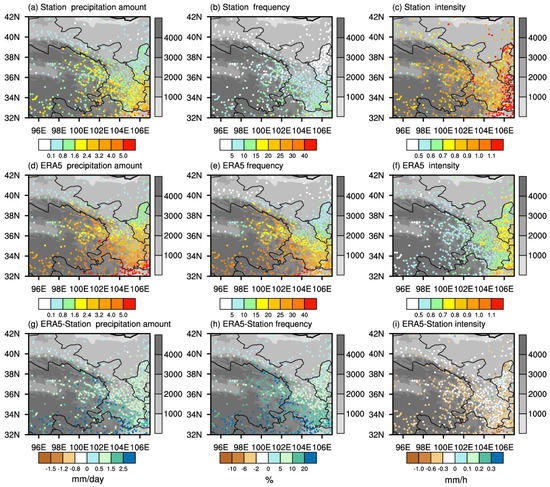
Figure 2.
Spatial distributions of 2012–2019 May to October mean (a,d,g) precipitation amount (mm day−1); (b,e,h) frequency (%); (c,f,i) intensity (mm h−1) from (a–c) rain gauges; (d–f) ERA5, and (g–i) differences between ERA5 and rain gauges. Gray shading, topography (m).
The distribution of precipitation frequency is similar to that of precipitation amount, which decreases from southeast to northwest, with slightly higher frequency in mountainous areas than that in plain areas (Figure 2b). The accuracy of ERA5 for precipitation frequency is lower than that of precipitation amount, with a pattern correlation coefficient of 0.66 and RMSE of 15% with observations. From the northwestern part of the Hexi Corridor to the western part of Inner Mongolia, the frequency of ERA5 data is close to the gauge observation, with deviation below 5%. Regions with the largest positive deviation in frequency are located in the southern mountainous areas and the eastern part of the Qilian Mountains, where positive deviation is greater than 20% (Figure 2h). Different from the larger frequency located in mountainous areas, large values of average intensity in the areas around the Qilian Mountains are located in the eastern plains. Intensity is larger in the east and smaller in the west. Intensity exceeds 1.1 mm h−1 along the edge from Ningxia to southeastern Gansu (Figure 2c). ERA5 reasonably described the spatial distribution of the intensity, but overall underestimated magnitude. The negative deviation of intensity in western mountainous areas was higher than that in the surrounding plains, which indicated that the overestimation of the amount in the western mountainous areas was mainly manifested by the high frequency.
Figure 3a shows the mean precipitation amount distributed with intensities over the Qilian Mountains (32–42° N,95–107° E). Precipitation with intensity below (upper) 4 mm h−1 was larger (smaller) than that observed in the ERA5 fitting results, indicating that ERA5 had the problem of overestimating weak precipitation and underestimating heavy precipitation. The α–β distribution of each station around the Qilian Mountains is shown in Figure 3b. Blue (red) shows less (more) amount of both weak and heavy rainfall. Green (sienna) shows less (more) amount of weak rainfall and more (less) rainfall amount of heavy rainfall. About 20% of the stations in the observation are located in the green area, indicating that strong precipitation contributes more to total precipitation in those stations. About 20% (15%) of the stations in the observation are located in the green (sienna) region, which far exceeds the two other regions, while the number of stations in the sienna region was the highest in ERA5 (Figure 3c).
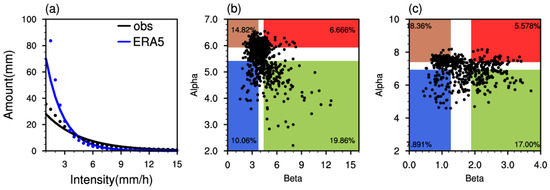
Figure 3.
(a) Precipitation amount (dots, mm y−1) and its exponential fitting (solid line) distributed with different intensities (mm h−1) over Qilian Mountains. Back denotes gauge observation, while blue is ERA5 rainfall. Parameters () of each station of (b) gauge observation and (c) ERA5 shown by markers on an plane. Four colored backgrounds denote four station groups. Blue (red) features less (more) weak and heavy rainfall. Green (sienna) features less (more) weak rainfall and more (less) heavy rainfall.
The spatial distribution of heavy (defined as intensity greater than or equal to 4 mm h−1) and weak (smaller than 4 mm h−1) precipitation indicates that weak precipitation occurs more frequently in mountainous areas and southeastern plains, while heavy precipitation occurs more frequently in plains (Figure 4). Positive deviation was found in most station locations in ERA5, which was more evident in the mountainous area (Figure 5a). The total amount of heavy precipitation in ERA5 was smaller than that of gauge observations, and the magnitude of deviation is larger in the mountainous and southeastern plain areas. In addition, over the 36° N–40° N, 99° E–104° E, the spatial variation in deviations for heavy and weak precipitation was related to altitude. The observed heavy and weak precipitation amount and frequency over the 36° N–40° N, 99° E–104° E increase with increasing gauge altitude. Figure 6 shows the relationship between elevation and rainfall amount, frequency, and intensity. With the increase in station elevation, precipitation amount, frequency, and intensity showed an increasing trend. The increase in precipitation amount and frequency was more significant with altitude in ERA5 compared to the stations (Figure 6a,b), but intensity decreased with increasing altitude (Figure 6c). The intensity of weak precipitation was positively correlated with elevation, while there was no significant trend of heavy precipitation with elevation in the observation (Figure 7a,c). This indicates that the increase in precipitation intensity with elevation is mainly influenced by weak precipitation. ERA5 generally reproduces the variation of both weak and heavy precipitation frequency with altitude but shows a noticeable difference in the distribution of intensity. Both the trend of weak and heavy precipitation is opposite to the observation, with precipitation intensity of ERA5 decreasing with altitude in weak precipitation and increasing with altitude in heavy precipitation. From the deviation of precipitation intensity and frequency with altitude, ERA5 was more likely to overestimate the frequency in stations with higher altitude, and failed to describe variation in intensity (Figure 7).

Figure 4.
Spatial distribution of weak (a,b, <4 mm h−1) and heavy (c,d, ≥4 mm h−1) precipitation from (a,c) ERA5 and (b,d) gauge observation. Gray shading, topography (m).
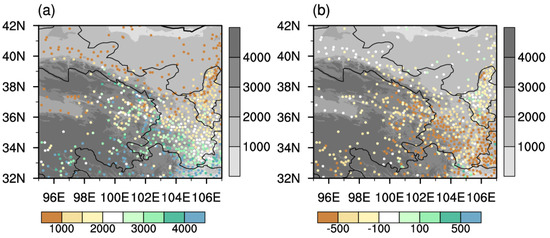
Figure 5.
Spatial distribution of differences in weak (a, <4 mm h−1) and heavy (b, ≥4 mm h−1) precipitation between ERA5 and observation. Gray shading, topography (m).
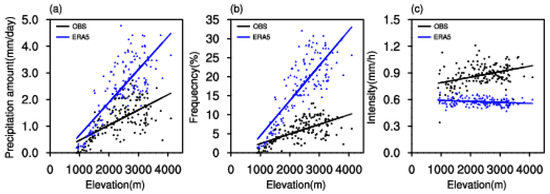
Figure 6.
Relationships between elevation (m) and rainfall (a) amount, (b) frequency, and (c) intensity in station over 36° N–40° N, 99° E–104° E. Dots are values at each station, and solid lines are linear fit. Black and blue are gauge observation and ERA5, respectively.
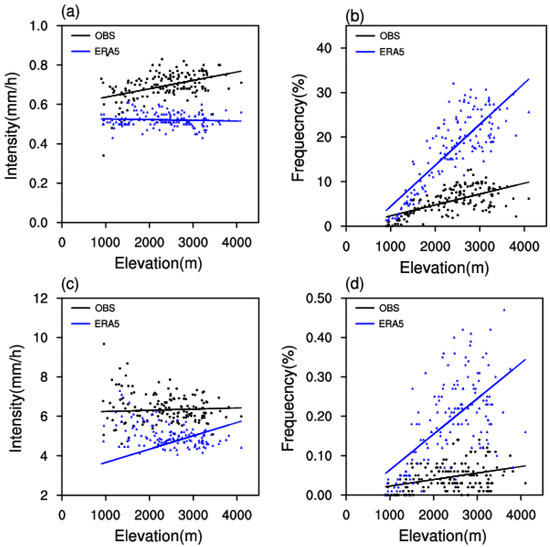
Figure 7.
Relationships between elevation (m) and rainfall (a,c) intensity, (b,d) frequency in station over 36° N–40° N, 99° E–104° E. (a,b) Weak precipitation (<4 mm h−1); (c,d) heavy precipitation (≥4 mm h−1). Dots are values at each station, and solid lines are linear fit. Black and blue are gauge observation and ERA5, respectively.
3.2. Diurnal Variation
The above results indicate that deviations in ERA5 precipitation are closely related to precipitation intensity. In this section, the deviation of different types of precipitation is discussed after the hourly time scale in conjunction with precipitation intensity. As shown in Figure 3b, the weak precipitation of ERA5 was greatly overestimated. Figure 8 further compares the diurnal variation of precipitation amount with intensities. The amplitude of diurnal variation of precipitation for different intensities in the observation was smaller than that of ERA5 (Figure 8a,b). For precipitation with intensity smaller than 3 mm h−1, ERA5 overestimated the amount at all hours during the day, with maximal deviation exceeding 6 mm y−1 from noon to afternoon (11–19 LT, local time). For precipitation of intensity greater than 4 mm h−1, the underestimation was concentrated at night, and the magnitude of deviation was much smaller than that of weak precipitation (Figure 8c).
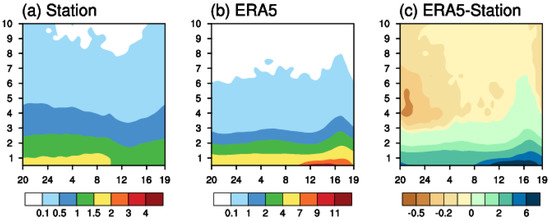
Figure 8.
Multiyear mean rainfall amount (mm y−1) at different intensities (y axis, mm h−1) and diurnal phases (x axis, local time) averaged over Qilian Mountains (32–42° N, 95–107° E) for (a) gauge observation, (b) ERA5, and (c) differences.
Precipitation is then classified according to intensity as smaller than 4 mm h–1 and great than 4 mm h−1, and its diurnal variation is separately compared. For weak precipitation with intensities smaller than 4 mm h−1, the observed precipitation exhibited an early morning peak, with the maximal precipitation occurring at 08 LT (local time). The peak of heavy precipitation above 4 mm h−1 occurred at 20 LT in the evening (Figure 9). Both types of precipitation in the observations had a single peak, while weak precipitation in ERA5 exhibited a single peak (peak at 18 LT in the evening). Heavy precipitation exhibited double peaks, with a stronger peak in the early morning, and a second in the evening (Figure 9b). Weak precipitation in ERA5 was about 4–5 times stronger than that observed (Figure 9a), with the largest deviation in the late afternoon (12–19 LT), while heavy precipitation is greater in the afternoon but lower at night (20–04 LT).
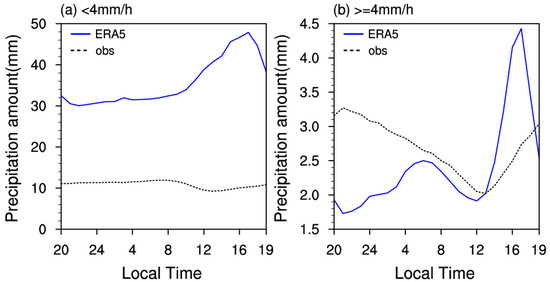
Figure 9.
Diurnal variation in (a) weak and (b) heavy precipitation amount averaged over 32–42° N, 95–107° E. Dashed lines are gauge observation, while solid lines are ERA5.
ERA5 showed an overestimation of weak precipitation in the afternoon and an underestimation of heavy precipitation at night-time. The most evident overestimation of weak precipitation and underestimation of heavy precipitation were in mountainous areas, and the precipitation amount of ERA5 in plain areas was closer to the observation. In most stations around the western mountains, the weak afternoon precipitation of ERA5 was about 5 times than that of the observation, but the heavy nocturnal precipitation was only one-tenth of the observation. Heavy nocturnal precipitation in the east–central plains of ERA5 was slightly better than that in the western mountains, about three-tenths of the observations (Figure 10). Figure 11 gives the variation in precipitation intensity with elevation over 36° N–40° N, 99° E–104° E. Results indicate that the intensity of weak afternoon rainfall was positively correlated with elevation, while heavy nocturnal rainfall intensity decreases with elevation. ERA5 generally reproduces the characteristic that the intensity of weak afternoon (heavy nocturnal) precipitation increases (decreases) with elevation. The higher the altitude is, the larger the positive deviation of weak afternoon precipitation (Figure 11a). Unlike weak afternoon precipitation, the underestimation of heavy nocturnal precipitation intensity in ERA5 was more obvious at lower elevations (Figure 11b).
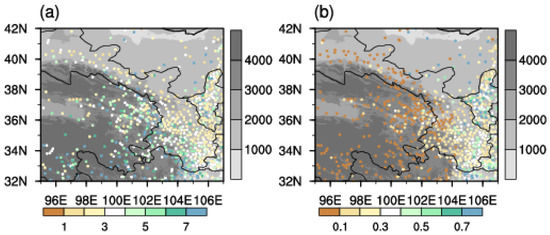
Figure 10.
The spatial distribution of the ratio of (a) weak precipitation in ERA5 to gauge observation in the afternoon (12–19 LT) and (b) heavy precipitation in ERA5 to observation in nocturnal hours (24–04 LT). Gray shadings indicate the topography (m).
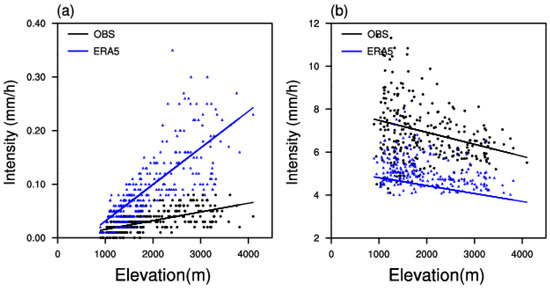
Figure 11.
Relationships between elevation (m) and rainfall intensity of (a) weak precipitation in afternoon (12–19 LT) and (b) heavy precipitation in nocturnal hours (24–04 LT) in the station over 36° N–40° N, 99° E–104° E. Dots are values at each station, and solid lines are linear fit. Black and blue are gauge observation and ERA5, respectively.
The duration of precipitation events is also an important metric to evaluate the characteristics of precipitation. Short rainfall events are more closely related to local thermal heating while long events are more influenced by synoptical systems [29]. Because only 28 events lasts longer than 20 h, Figure 12 only displays events lasting no longer than 20 h. Around the Qilian Mountains, precipitation events were observed with durations shorter than the 4 h peak in the late afternoon, while peaks were gradually delayed from late afternoon to night with increasing duration (Figure 12a). ERA5 represented the late afternoon peak well for events shorter than 4 h. For events lasting 4–12 h, ERA5 still showed late-afternoon peaks, which was much earlier than that in the observation. For events longer than 12 h, diurnal amplitude was weaker in ERA5, and peaks occurred in the early morning, which lagged behind observations (Figure 12b).
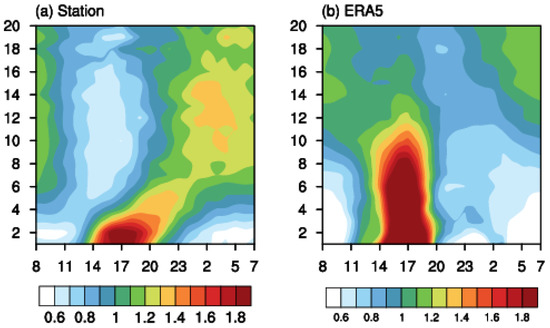
Figure 12.
Rainfall amount standardized for different durations (y axis, h) and diurnal phases (x axis, LT) averaged over 32–42° N, 95–107° E for (a) gauge observation, and (b) ERA5.
For short (≤4 h) and long (≥12 h) events, the diurnal peak in both gauge observation and ERA5 was mainly concentrated at 14–23 and 23–09 LT, respectively. Figure 13 gives the ratios of the short afternoon and long nocturnal events from ERA5 to the observed. The short afternoon precipitation ratio is calculated by dividing precipitation in 14–23 LT for short events by the sum of all short events, and the difference of ratio means the short afternoon precipitation ratio of ERA5 minus that of the observation. The calculation of the long nocturnal precipitation ratio is similar. ERA5 overestimated short precipitation in the afternoon and underestimated long precipitation at night, with the largest deviation appearing in the Qilian Mountains (Figure 13a,b). Figure 14 shows the standardized diurnal curves of rainfall amounts and frequency of the Qilian Mountains. The diurnal cycle has a late-afternoon peak in both short and long events (Figure 14a,c). ERA5 reasonably reproduced the afternoon peak of the amount for both short and long events, but failed to represents the nocturnal peak of frequency. There was evident positive (negative) bias of afternoon (nocturnal) precipitation amount, which is related with the high (low) frequency of afternoon (nocturnal) precipitation (Figure 14b,d).
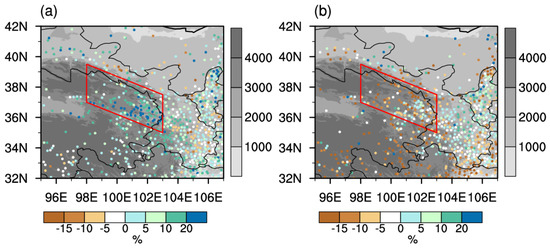
Figure 13.
Spatial distribution of proportional difference of ERA5 and observation (a) short afternoon rainfall to all rainfall of short events. (b) Same as (a), but for proportion of long nocturnal precipitation to all rainfall of long events. Short afternoon (long nocturnal) precipitation means precipitation with duration less than 4 h (greater than 12 h) that occurs at 12–19 LT (24–04 LT). Gray shading, topography (m).
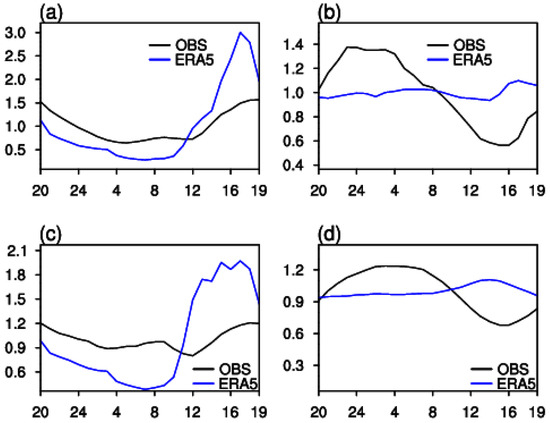
Figure 14.
Diurnal variation of short- and long-duration precipitation (a,c) amount and (b,d) frequency averaged over 32–42° N, 95–107° E. (a,b) are short-duration events;(c,d) are long-duration events. The black and blue are gauge observation and ERA5, respectively.
4. Discussion
Regional differences in rainfall over the Qilian Mountains are closely related to the topography. The Qilian Mountains include many mountains ranging from the southeast to the northeast. The southern side of the Qilian Mountains is the location of Qinghai Lake, and the Hexi Corridor is on the northern side. Wang et al. [32] indicated that altitude is the primary variable governing the spatial distribution of precipitation over the Qilian Mountains, and precipitation–altitude relationships are statistically significant in this region. Li et al. [33] also found that the total summer rainfall amounts and frequencies increase with elevation over the Qilian Mountains. Our evaluation shows that the bias of ERA5 precipitation over the Qilian Mountains is also closely related to elevation. The positive deviation in weak precipitation and the negative deviation in heavy precipitation in the mountainous area were larger than those in the plains, which may be related to the water vapor distribution in reanalysis. Surface humidity is a critical variable in determining the spatial distribution of precipitation [34,35]. ERA5 is more accurate in humidity than ERA-I is over the Tibetan Plateau [36], but still represents large bias around the Qilian Mountains. The surface-specific humidity of ERA5 and the observation, and their difference are shown in Figure 15. There was a noticeable difference in specific humidity between ERA5 and the observation. In gauge observation, the specific humidity over the mountainous and eastern plain areas was larger; over the transition slope zone, it was smaller. ERA5 showed larger specific humidity in the Hexi Corridor and western Inner Mongolia, and smaller in the mountainous areas (Figure 15a,b). The negative deviation in mean specific humidity over 36° N–40° N, 99° E–104° E is over −2 g/kg. Investigating deviation with elevation shows that the mean specific humidity corresponding to both weak and heavy precipitation in ERA5 was smaller than that of the observation, and the negative deviation of weak (heavy) precipitation also increased (decreased) with the station’s altitude (Figure 16). The specific humidity of heavy rainfall in ERA5 was obviously less than that of the observation at low altitudes. With the increase in elevation, the specific humidity in ERA5 gradually increased and is comparable to that of the observation (Figure 16b), which corresponds to the different distributions of intensity between ERA5 and the observation in heavy precipitation (Figure 7c).

Figure 15.
Spatial distributions of 2012–2019 May to October mean specific humidity (g/kg) from (a) rain gauges, (b) ERA5, and (c) differences between ERA5 and rain gauges. Gray shading, topography (m).
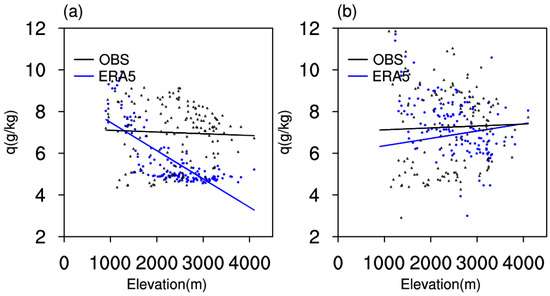
Figure 16.
Relationships between the elevation (m) and specific humidity of (a) weak and (b) heavy precipitation in the station over 36° N–40° N, 99° E–104° E. The dots are values at each station and solid lines are linear fit. The black and blue are gauge observation and ERA5, respectively.
This study focused on the ability of ERA5 to represent mean precipitation characteristics around the Qilian Mountains. Nevertheless, deviations in precipitation processes could be different under various synoptical systems. Precipitation caused by strong synoptical forcings is relatively reliable in reanalysis [37]. For example, ERA5 reanalysis reasonably reproduces relevant synoptic-scale features of severe local storms [38]. However, ERA5 may be highly susceptible to omissions for weak precipitation processes with shallow wet layers, saturated layers, and high lifting condensation heights [39]. Therefore, ERA5 bias related to synoptical systems still needs further investigation.
Evaluation was based on gauge observations in this study, but attention should be paid to the uncertainty of observational data, especially over regions with complex terrain. Due to the complicated surface and the uneven distribution of gauges, a gauge observation may only represent rainfall in a limited area. For example, previous studies found that Tropical Rainfall Measuring Mission (TRMM) exhibited double peaks in both rainfall amount and frequency over the Tibetan Plateau, which is different from the results of the rain-gauge dataset [40,41,42]. The difference is related to the fact that stations are primarily located in the valley [43]. Rain-gauge data may better represent rainfall characteristics at lower elevations with better spatial representation than that in higher regions due to the unequal distribution of gauges. Given the inverse relationship between elevation and rain-gauge density, extreme values could be missed in high-elevation areas (with less stations per area). So, the current gauge network (Figure 1b) as validation data may be expected to be biased towards characteristics of lowland areas. Improving this situation would not only require to install a denser rain-gauge network, but also to work towards a more equal spatial distribution in high- and low-elevation areas.
5. Conclusions
On the basis of hourly rain-gauge data from 735 stations over the Qilian Mountains in Northwest China, we presented a detailed assessment of ERA5 reanalysis data in terms of precipitation amount, frequency, intensity, and diurnal variation. These results provide metrics for the assessment of hourly precipitation characteristics in complex topographic areas. The main results are summarized as follows.
- (1)
- Comparing hourly frequency and intensity showed that ERA5 overestimated precipitation amount and frequency, and underestimated intensity at most stations around the Qilian Mountains and its surrounding area. ERA5 underestimated heavy precipitation with intensity greater than 4 mm h−1, which was most evident over mountainous areas. Weaker precipitation with intensity smaller than 4 mm h−1 is generally overestimated.
- (2)
- ERA5 data showed large deviation in representing diurnal variation around the Qilian Mountains and their surroundings. For different intensities of rainfall, ERA5 basically reproduced a late-afternoon peak, while the nocturnal peak appeared in gauge observations, especially for weak rainfall. Investigating rainfall events with different durations showed that ERA5 reasonably represented the afternoon peak for events shorter than 4 h, but showed evident bias for longer events. The most evident deviation of both short and long events was located near the Qilian Mountains. The deviation of short afternoon (long nocturnal) rainfall events corresponded to precipitation frequency well.
- (3)
- The relationship between elevation and rainfall distribution indicated that variation in weak and heavy rainfall frequency with elevation could be reproduced in ERA5, while the trend of intensity was contrary to the observation. Deviation in weak afternoon (heavy nocturnal) rainfall intensity increased (decreased) with elevation. The bias of rainfall intensity with elevation may have been related to the distribution of surface-specific humidity with elevation.
In this study, the ERA5 reanalysis data were evaluated for their ability to capture hourly rainfall characteristics over the Qilian Mountains. Results provided deviation information of ERA5 precipitation products using metrics such as amount-intensity structure, duration, and diurnal variability. The metrics introduced and applied in this study, including precipitation frequency, intensity, and their diurnal variations, could also be promoted and used to evaluate other reanalysis datasets and gridded precipitation products to represent fidelity in terms of precipitation characteristics at finer scales (particularly at the sub-daily/hourly scale), which has potential value to other studies focusing on this area.
Author Contributions
Conceptualization, H.C. and R.Y.; methodology, H.C.; validation, M.H., H.C. and R.Y.; formal analysis, H.C.; investigation, M.H., H.C. and R.Y.; writing—original draft preparation, M.H. and H.C.; writing—review and editing, M.H., H.C. and R.Y.; visualization, M.H.; supervision, H.C. and R.Y. All authors have read and agreed to the published version of the manuscript.
Funding
This research was funded by the National Key R&D Program of China (2018YFC1507605) and the National Natural Science Foundation of China (U2142214, 42075154).
Institutional Review Board Statement
Not applicable.
Informed Consent Statement
Not applicable.
Data Availability Statement
Gauge data are available from http://data.cma.cn/en/?r=data/detail&dataCode=A.0012.0001, accessed on 1 January 2022; ERA5 reanalysis data are available from http://climate.copernicus.eu/products/climate-reanalysis, accessed on 1 January 2022.
Acknowledgments
The authors wish to thank the National Meteorological Information Center of China Meteorological Administration for providing the precipitation data (http://data.cma.cn/en, accessed on 1 January 2022), and the European Centre for Medium-Range Weather Forecasts for the ERA5 reanalysis data (http://climate.copernicus.eu/products/climate-reanalysis, accessed on 1 January 2022). We appreciate the comments from the three anonymous reviewers and the editor that helped to improve the manuscript.
Conflicts of Interest
The authors declare no conflict of interest.
References
- Trenberth, K.E.; Dai, A.; Rasmussen, R.M.; Parsons, D.B. The changing character of precipitation. Bull. Am. Meteorol. Soc. 2015, 84, 1205–1217. [Google Scholar] [CrossRef]
- Kidd, C.; Huffman, G. Global precipitation measurement. Meteorol. Appl. 2011, 18, 334–353. [Google Scholar] [CrossRef]
- Donat, M.G.; Lowry, A.L.; Alexander, L.V.; O’Gorman, P.A.; Maher, N. More extreme precipitation in the world’s dry and wet regions. Nat. Clim. Chang. 2016, 6, 508–513. [Google Scholar] [CrossRef]
- Tarek, M.; Brissette, F.P.; Arsenault, R. Evaluation of the ERA5 reanalysis as a potential reference dataset for hydrological modelling over North America. Hydrol. Earth Syst. Sci. 2020, 24, 2527–2544. [Google Scholar] [CrossRef]
- Zhang, L.; Li, X.; Cao, Y.; Nan, Z.; Wang, W.; Ge, Y.; Wang, P.; Yu, W. Evaluation and integration of the top-down and bottom-up satellite precipitation products over mainland China. J. Hydrol. 2020, 581, 124456. [Google Scholar] [CrossRef]
- Bosilovich, M.G.; Chen, J.Y.; Robertson, F.R.; Adler, R.F. Evaluation of global precipitation in reanalyses. J. Appl. Meteorol. Climatol. 2008, 47, 2279–2299. [Google Scholar] [CrossRef]
- Dee, D.P.; Balmaseda, M.; Balsamo, G.; Engelen, R.; Thepaut, J.N. Toward a consistent reanalysis of the climate system. Bull. Am. Meteorol. Soc. 2014, 95, 1235–1248. [Google Scholar] [CrossRef]
- Hersbach, H.; Bell, B.; Berrisford, P.; Hirahara, S.; Horanyi, A.; Muñoz-Sabater, J.; Nicolas, J.; Peubey, C.; Radu, R.; Schepers, D.; et al. The ERA5 global reanalysis. Q. J. R. Meteorol. Soc. 2020, 146, 1999–2049. [Google Scholar] [CrossRef]
- Beck, H.E.; Pan, M.; Roy, T.; Weedon, G.P.; Pappenberger, F. Daily evaluation of 26 precipitation datasets using Stage-IV gauge-radar data for the CONUS. Hydrol. Earth Syst. Sci. 2019, 23, 207–224. [Google Scholar] [CrossRef] [Green Version]
- Nogueira, M. Inter-comparison of ERA-5, ERA-Interim and GPCP rainfall over the last 40 years: Process-based analysis of systematic and random differences. J. Hydrol. 2020, 583, 124632. [Google Scholar] [CrossRef]
- Malayeri, A.K.; Saghafian, B.; Raziei, T. Performance evaluation of ERA5 precipitation estimates across Iran. Arab. J. Geosci. 2021, 14, 1–18. [Google Scholar] [CrossRef]
- Jiao, D.; Xu, N.; Yang, F.; Xu, K. Evaluation of spatial-temporal variation performance of ERA5 precipitation data in China. Sci. Rep. 2021, 11, 17956. [Google Scholar] [CrossRef] [PubMed]
- Jiang, Q.; Li, W.; Fan, Z.; He, X.; Sun, W.; Chen, S.; Wen, J.; Gao, J.; Wang, J. Evaluation of the ERA5 reanalysis precipitation dataset over Chinese Mainland. J. Hydrol. 2021, 595, 125660. [Google Scholar] [CrossRef]
- Muschinski, T.; Katz, J.I. Trends in hourly rainfall statistics in the United States under a warming climate. Nat. Clim. Chang. 2013, 3, 577–580. [Google Scholar] [CrossRef]
- Cattoen, C.; Robertson, D.E.; Bennett, J.C.; Wang, Q.J.; Carey-Smith, T.K. Calibrating Hourly Precipitation forecasts with Daily Observations. J. Hydrometeorol. 2020, 21, 1655–1673. [Google Scholar] [CrossRef]
- Qin, S.; Wang, K.; Wu, G.; Ma, Z. Variability of hourly precipitation during the warm season over eastern China using gauge observations and ERA5. Atmos. Res. 2021, 264, 105872. [Google Scholar] [CrossRef]
- Hu, X.; Yuan, W. Evaluation of ERA5 precipitation over the eastern periphery of the Tibetan plateau from the perspective of regional rainfall events. Int. J. Climatol. 2021, 41, 2625–2637. [Google Scholar] [CrossRef]
- Amjad, M.; Yilmaz, M.T.; Yucel, I.; Yilmaz, K.K. Performance evaluation of satellite-and model-based precipitation products over varying climate and complex topography. J. Hydrol. 2020, 584, 124707. [Google Scholar] [CrossRef]
- Chen, Y.; Sharma, S.; Zhou, X.; Yang, K.; Li, X.; Niu, X.; Hu, X.; Khadka, N. Spatial performance of multiple reanalysis precipitation datasets on the southern slope of central Himalaya. Atmos. Res. 2021, 250, 105365. [Google Scholar] [CrossRef]
- Derin, Y.; Yilmaz, K.K. Evaluation of multiple satellite-based precipitation products over complex topography. J. Hydrometorol. 2014, 15, 1498–1516. [Google Scholar] [CrossRef] [Green Version]
- Bui, H.T.; Ishidaira, H.; Shaowei, N. Evaluation of the use of global satellite–gauge and satellite-only precipitation products in stream flow simulations. Appl. Water Sci. 2019, 9, 53. [Google Scholar] [CrossRef] [Green Version]
- Crossett, C.C.; Betts, A.K.; Dupigny-Giroux, L.-A.L.; Bomblies, A. Evaluation of Daily Precipitation from the ERA5 Global Reanalysis against GHCN Observations in the Northeastern United States. Climate 2020, 8, 148. [Google Scholar] [CrossRef]
- Zhao, P.; Li, Y.; Guo, X.; Xu, X.; Liu, Y.; Tang, S.; Xiao, W.; Shi, C.; Ma, Y.; Yu, X.; et al. The Tibetan Plateau surface-atmosphere coupling system and its weather and climate effects: The Third Tibetan Plateau Atmospheric Scientific Experiment. Acta Meteorol. Sin. 2018, 76, 833–860. [Google Scholar] [CrossRef]
- Yuan, X.; Yang, K.; Lu, H.; He, J.; Sun, J.; Wang, Y. Characterizing the features of precipitation for the Tibetan Plateau among four gridded datasets: Detection accuracy and spatio-temporal variabilities. Atmos. Res. 2021, 264, 105875. [Google Scholar] [CrossRef]
- Huang, J.; Li, Y.; Fu, C.; Chen, F.; Fu, W.; Dai, A.; Shinoda, M.; Ma, Z.; Guo, W.; Li, Z.; et al. Dryland climate change: Recent progress and challenges. Rev. Geophys. 2017, 55, 719–778. [Google Scholar] [CrossRef]
- Zhang, Q.; Zhao, Y.; Fan, S. Development of hourly precipitation datasets for national meteorological stations in China. Torrential Rain Disaster 2016, 35, 182–186. [Google Scholar]
- Brown, B.G.; Atger, F.; Brooks, H.; Wilson, L. Recommendations for the verification and intercomparison of QPFs and PQPFs from operational NWP models. Revision 2008, 2, 2009-1. [Google Scholar]
- Zhou, T.; Yu, R.; Chen, H.; Dai, A.; Pan, Y. Summer precipitation frequency, intensity, and diurnal cycle over China: A comparison of satellite data with rain gauge observations. J. Clim. 2008, 21, 3997–4010. [Google Scholar] [CrossRef]
- Yu, R.; Xu, Y.; Zhou, T.; Li, J. Relation between rainfall duration and diurnal variation in the warm season precipitation over central eastern China. Geophys. Res. Lett. 2007, 34, L13703. [Google Scholar] [CrossRef] [Green Version]
- Yu, R.; Li, J.; Zhang, Y.; Chen, H. Improvement of rainfall simulation on the steep edge of the Tibetan Plateau by using a finite-difference transport scheme in CAM5. Clim. Dyn. 2015, 45, 2937–2948. [Google Scholar] [CrossRef]
- Yu, R.; Li, J. Hourly rainfall changes in response to surface air temperature over eastern contiguous China. J. Clim. 2012, 25, 6851–6861. [Google Scholar] [CrossRef]
- Wang, L.; Chen, R.; Song, Y.; Yang, Y.; Liu, J.; Han, C.; Liu, Z. Precipitation–altitude relationships on different timescales and at different precipitation magnitudes in the Qilian Mountains. Theor. Appl. Climatol. 2018, 134, 875–884. [Google Scholar] [CrossRef]
- Li, L.; Li, J.; Chen, H.; Yu, R. Diurnal variations of summer precipitation over the Qilian Mountains in Northwest China. J. Meteorol. Res. 2019, 33, 18–30. [Google Scholar] [CrossRef]
- Keil, C.; Röpnack, A.; Craig, G.C.; Schumann, U. Sensitivity of quantitative precipitation forecast to height dependent changes in humidity. Geophys. Res. Lett. 2008, 35(9), L09812. [Google Scholar] [CrossRef] [Green Version]
- Song, Y.; Liu, Y.; Ding, Y. A study of surface humidity changes in China during the recent 50 years. Acta Meteorol. Sin. 2012, 26, 541–553. [Google Scholar] [CrossRef]
- Zhang, J.; Zhao, T.; Li, Z.; Li, C.; Li, Z.; Ying, K.; Shi, C.; Jiang, L.; Zhang, W. Evaluation of Surface Relative Humidity in China from the CRA-40 and Current Reanalyses. Adv. Atmos. Sci. 2021, 38, 1958–1976. [Google Scholar] [CrossRef]
- Keil, C.; Heinlein, F.; Craig, G.C. The convective adjustment time-scale as indicator of predictability of convective precipitation. Q. J. R. Meteorol. Soc. 2014, 140, 480–490. [Google Scholar] [CrossRef]
- Li, F.; Chavas, D.R.; Reed, K.A.; Dawson, D.T., II. Climatology of severe local storm environments and synoptic-scale features over North America in ERA5 reanalysis and CAM6 simulation. J. Clim. 2020, 33, 8339–8365. [Google Scholar] [CrossRef]
- Sun, J.; Ma, X.; Dai, K. Analysis of Unsuccessful Forecasts of Several Weak Rainfall Processes in Beijing. Meteorol. Mon. 2018, 44, 26–41. [Google Scholar]
- Yu, R.; Zhou, T.; Xiong, A.; Zhu, Y.; Li, J. Diurnal variations of summer precipitation over contiguous China. Geophys. Res. Lett. 2007, 34, L01704. [Google Scholar] [CrossRef] [Green Version]
- Liu, L.; Feng, J.; Chu, R.; Zhou, Y.; Uene, K. The diurnal variation of precipitation in monsoon season in the Tibetan Plateau. Adv. Atmos. Sci. 2002, 19, 365–378. [Google Scholar]
- Singh, P.; Nakamura, K. Diurnal variation in summer precipitation over the central Tibetan Plateau. J. Geophys. Res. 2009, 114, D20107. [Google Scholar] [CrossRef]
- Chen, H.M.; Yuan, W.H.; Li, J.; Yu, R.C. A possible cause for different diurnal variations of warm season rainfall as shown in station observations and TRMM 3B42 data over the southeastern Tibetan Plateau. Adv. Atmos. Sci. 2012, 29, 193–200. [Google Scholar] [CrossRef]
Publisher’s Note: MDPI stays neutral with regard to jurisdictional claims in published maps and institutional affiliations. |
© 2022 by the authors. Licensee MDPI, Basel, Switzerland. This article is an open access article distributed under the terms and conditions of the Creative Commons Attribution (CC BY) license (https://creativecommons.org/licenses/by/4.0/).